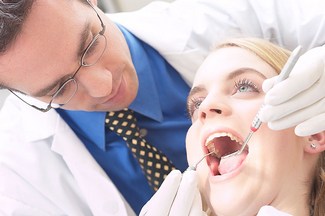Oral Cancer and Smoking
 |
Oral cancer claims one life every hour in the U.S. - and it is of great concern to many dental practices. Almost 70% of its victims are diagnosed in later stages, so survival is extremely poor. Approximately 50% die within 5 years. However, when discovered in its early stages, cancer of the mouth is 90% survivable. |
Tobacco's Effect on The Mouth
- Oral cancer
- Bad breath or halitosis
- Black hairy tongue
- Gum recession
- Delayed healing of the gums
- Increased severity of periodontal disease
- Nicotinic stomatitis (smoker's palate)
- Dental Caries
- Staining and tar deposits remaining on the teeth
Cancer of the Mouth
Oral Cancer is any cancerous tissue growth located in the mouth. Oral or mouth cancer most commonly involves the tissue of the lips or the tongue. It may also occur on the floor of the mouth, cheek lining, gingiva (gums), or palate (roof of the mouth). Smoking and other tobacco use are associated with about 75% of oral cancer cases, caused by irritation of the mucous membranes of the mouth from smoke and heat of cigarettes, cigars, and pipes. Tobacco contains over 19 known carcinogens, and the combustion of it, and by products from this process, is the primary mode of involvement. Use of chewing tobacco or snuff causes irritation from direct contact with the mucous membranes.
An examination of the mouth by the health care provider or dentist shows a visible and/or palpable (can be felt) lesion of the lip, tongue, or other mouth area. As the tumor enlarges, it may become an ulcer and bleed. Speech/talking difficulties, chewing problems, or swallowing difficulties may develop, particularly if the cancer is on the tongue. While a dentist, physician or other medical professional may suspect a particular lesion is malignant, the only definitive method for determining this is through biopsy and microscopic evaluation of the cells in the removed sample. A tissue biopsy, whether of the tongue or other oral tissues, and microscopic examination of the lesion confirm the diagnosis of oral cancer.
Surgical excision (removal) of the tumor is usually recommended if the tumor is small enough, and if surgery is likely to result in a functionally satisfactory result. Radiation therapy is often used in conjunction with surgery, or as the definitive radical treatment, especially if the tumor is inoperable. Chemotherapy is commonly used for more advanced tumors, often in combination with radiotherapy and surgery. Biological agents, such as Cetuximab have recently been shown to be effective in the treatment of squamous cell head and neck cancers, and are likely to have an increasing role in the future management of this condition.
Given the vital nature of the structures in the head and neck area, surgery for larger cancers is technically demanding. Reconstructive surgery may be required in order to give the patient an acceptable cosmetic and functional result. Bone grafts and surgical flaps such as the radial forearm flap are, used to help rebuild the structures removed during excision of the cancer.
Survival rates for oral cancer depend on the precise site, and the stage of the cancer. Overall, survival is around 50% at five years when all stages of initial diagnosis are considered. Survival rates for stage 1 cancers are 90%. This is why there is emphasis on early detection in order to increase the survival outcome of patients.
Surgical Procedures
The surgical procedures involved with cancer of the mouth are listed below. Following treatment, rehabilitation may be necessary to improve movement, chewing, swallowing, and speech.
- Glossectomy - involves the removal of part or all of the tongue
- Radical neck dissection
- Mandibulectomy - involves the removal of the mandible or lower jaw
- Maxillectomy - involves the removal of the maxilla or upper jaw. It can be done with or without orbital exenteration)
- Moh's procedure
- Laryngectomy - involves removal of part or all of the larynx. The patient is left with a tracheostomy opening.
- Postoperative disfigurement of the face, head and neck
- Complications of radiation therapy, including dry mouth and difficulty swallowing
- Other metastasis (spread) of the cancer
Complications of surgery may include:
Alarmingly, more than 25% of these types of cancer victims have no lifestyle risk factors such as tobacco use, alcohol use, diabetes, or HIV.* Everyone age 18 and older is considered at increased risk. Individuals considered high risk are adults age 40 or older and tobacco users regardless of age. At highest risk are those age 40 and older with lifestyle risk factors such as tobacco use, alcohol use, diabetes, HIV, and those with a history of oral cancer. Because early detection of oral cancer is the key to successful outcomes, it is important that you get an annual dental checkup which includes a screening for oral abnormalities that could lead to cancer.

